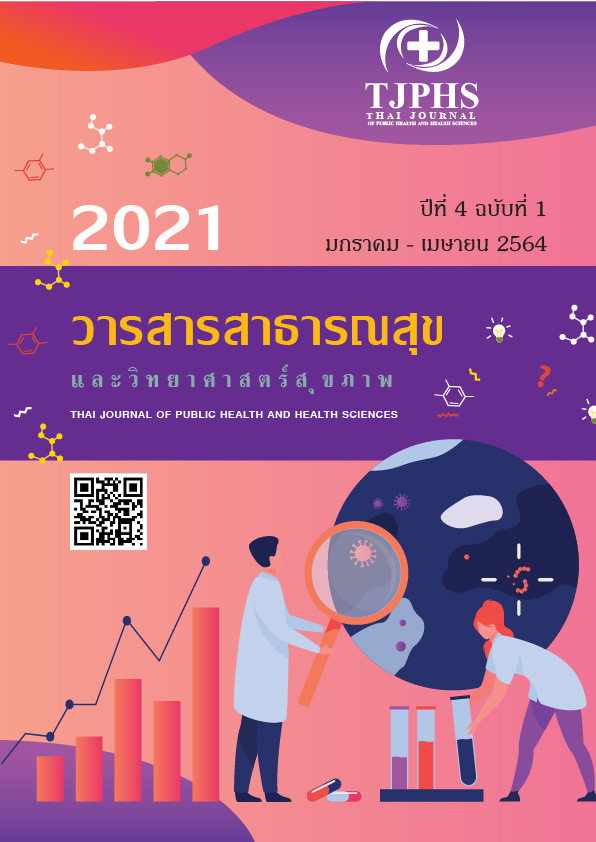ความชุกและปัจจัยที่มีผลต่อการเกิดความรุนแรงในสถานที่ทำงานของบุคลากรในโรงพยาบาลชุมชนแม่ข่ายของรัฐแห่งหนึ่งในภาคใต้
คำสำคัญ:
ความรุนแรงในสถานที่ทำงาน, โรงพยาบาล, บุคลากรบทคัดย่อ
การวิจัยนี้เป็นการวิจัยแบบภาคตัดขวางเชิงวิเคราะห์ มีวัตถุประสงค์เพื่อศึกษาความชุก ลักษณะ ผลกระทบและการจัดการกับความรุนแรงที่เกิดขึ้นในสถานที่ทำงาน และค้นหาปัจจัยที่มีผลต่อการเกิดความรุนแรงในสถานที่ทำงานของบุคลากรในโรงพยาบาลชุมชนแม่ข่ายของรัฐแห่งหนึ่งในภาคใต้ เก็บข้อมูลโดยใช้แบบสอบถามชนิดตอบด้วยตนเองที่สร้างขึ้นจากการทบทวนวรรณกรรม ตรวจสอบความเที่ยงตรงเชิงเนื้อหาโดยผู้ทรงคุณวุฒิจำนวน 3 ท่านเครื่องมือวิจัยที่ใช้มีค่าสัมประสิทธิ์แอลฟา ของปัจจัยด้านองค์กร ด้านบุคลากรและด้านผู้ก่อเหตุความรุนแรง เท่ากับ 0.89, 0.75 และ 0.80 ตามลำดับ เก็บรวบรวมข้อมูลในเดือนกรกฎาคม-สิงหาคม พ.ศ.2563
ผลการศึกษา ความชุกของการถูกกระทำความรุนแรงในสถานที่ทำงาน คิดเป็นร้อยละ 47.09 ความรุนแรงทางวาจา ร้อยละ 45.87 การกลั่นแกล้งรังแก ร้อยละ 11.62 ความรุนแรงทางกาย ร้อยละ 7.95 ความรุนแรงทางเพศ ร้อยละ 2.75 จุดเกิดเหตุที่พบบ่อย ได้แก่ ห้องฉุกเฉิน คลินิกผู้ป่วยนอก/คลินิกเฉพาะโรค ผู้ป่วยคือผู้ก่อเหตุความรุนแรงทางกายและความรุนแรงทางเพศสูงที่สุด ญาติผู้ป่วย คือผู้ก่อเหตุความรุนแรงทางวาจาสูงที่สุด ผู้ร่วมงานในแผนกเดียวกันคือผู้กลั่นแกล้งรังแกสูงที่สุด ผลกระทบ เสียใจ โกรธ เครียด การจัดการกับความรุนแรงที่เกิดขึ้น ส่วนใหญ่ใช้วิธีคุยกับเพื่อนร่วมงาน เขียนบันทึกรายงานเหตุการณ์ค่อนข้างน้อย
ปัจจัยที่มีผลต่อการเกิดความรุนแรงอย่างมีนัยสำคัญทางสถิติ (Binary logistic regression) ได้แก่ เพศชาย ลักษณะงานหมุนเวียนเป็นกะ ส่งผลต่อการเกิดความรุนแรงทางกาย สถานที่ปฏิบัติงาน คลินิกผู้ป่วยนอก คลินิกเฉพาะโรค ลักษณะงานหมุนเวียนเป็นกะ ส่งผลต่อการเกิดความรุนแรงทางวาจา ในขณะที่ประสบการณ์ปฏิบัติงาน ≤ 1 ปี ลดการเกิดความรุนแรงทางวาจา นโยบายต่อต้านความรุนแรงที่มีความชัดเจน ลดการเกิดความรุนแรงทางกาย ระบบการรักษาความปลอดภัยที่มีประสิทธิภาพ ความเครียด/กดดันจากสถานการณ์เร่งด่วนต่ำ ลดการเกิดความรุนแรงทางวาจา การสื่อสารให้ข้อมูลที่มีประสิทธิภาพต่ำ ส่งผลต่อการเกิดความรุนแรงทางกาย วาจา และการกลั่นแกล้งรังแก ผู้ก่อเหตุที่มีพฤติกรรมก้าวร้าว ส่งผลต่อการเกิดความรุนแรงทางวาจาและการกลั่นแกล้งรังแก
สรุปผลการศึกษา เกือบครึ่งหนึ่งของบุคลากรในโรงพยาบาลเคยถูกกระทำความรุนแรงในสถานที่ทำงาน ส่งผลกระทบทั้งด้านร่างกาย จิตใจและการทำงาน การแก้ปัญหาเพื่อลดความรุนแรงจำเป็นต้องกำหนดนโยบาย วางแผนสร้างมาตรการการเฝ้าระวังและรายงานอุบัติการณ์ รวมทั้งการเยียวยาบุคลากรตามความเหมาะสม
เอกสารอ้างอิง
Anand, T., Grover, S., Kumar, R., Kumar, M., Ingle, GK. (2016). Workplace violence against resident doctors in a tertiary care hospital in Delhi. Natl Med J India, 29, 344-8. Retrieved from: http://www.nmji.in/text.asp?2016/29/6/344/202433.
Arnetz, JE., Hamblin, L., Essenmacher, L., Upfal, MJ., Ager, J., Luborsky, M. (2015). Understanding
patient-to-worker violence in hospitals: a qualitative analysis of documented incident reports. J Adv Nurs, 71(2), 338-348.
Bartlett JE, Bartlett ME. (2011) Workplace bullying: an integrative literature review.
Advances in Developing Human Resources, 69-84. Retrieved from https://www.researchgate.net/publication/254074469_Workplace_Bullying_An_Integrative_Literature_Review.
Best, J.W. (1981). Research in education. New Jersey: Prentice Hall 4th ed, 78.
Bureau of Information Office of The Permanent Secretary of MOPH. (2018). 2P Safety
Hospital. Retrieved from https://pr.moph.go.th/?url=pr/detail/2/04/118987/. (in Thai)
Chayyaphong, A., Lormphongs, S., & Phatarabuddha, N. (2017). Factors related to effects of workplace violence among nurses in primary care hospital, Samut Prakan Province. Disease control journal, 43(4), 413-422. (in Thai)
Cheung, T., Lee, P. H., & Yip, P. (2017). Workplace Violence toward Physicians and Nurses: Prevalence and Correlates in Macau. International journal of environmental research and public health, 14(8), 879. Retrieved 16, 2019 from https://doi.org/10.3390/ijerph14080879.
Disbunjong, W., Suthakorn, W., & Kaewthummanukul, T. (2009). Working Environment and Workplace Violence among Nursing Personnel. Journal of The Royal Thai Army Nurses, 10(1), 32-42. Retrieved from https://he01.tci-thaijo.org/index.php/JRTAN/article/view/5722. (in Thai)
Huaiyot Hospital. (2019). Annual hospital statistical report. Retrieved from http://www.huaiyothospital.go.th/#module=statistics2562.
ILO/ICN/WHO/PSI. (2003). Work-related violence in the Health Sector country case
Studies Research Instruments – Survey Questionnaire. Geneva, Joint Programme
on Work-related violence in the Health Sector. Retrieved from https://www.who.int/
violence_injury_prevention/violence/interpersonal/en/WVmanagementvictimspaper.pdf.
ILO. (2013). Work-related violence and its integration into existing surveys, Nineteenth International Conference of Labour Statisticians, Geneva, 2013. Retrieved from https://www.ilo.org/
wcmsp5/groups/public/---dgreports/-stat/documents/meetingdocument/wcms_222231.pdf.
Likert, R. (1961). New Patterns of Management. New York: McGraw-Hill Book Company Inc.
Liu, H., Zhao, S., Jiao, M., Wang, J., Peters, D.H., Qiao, H., et al. (2015). Extent, Nature, and Risk Factors of Workplace Violence in Public Tertiary Hospitals in China: A Cross-Sectional Survey. International journal of environmental research and public health, 12(6), 6801–6817. Retrieved from https://doi.org/10.3390/ijerph120606801.
Najafi, F., Fallahi-Khoshknab, M., Ahmadi, F., Dalvandi, A., & Rahgozar, M. (2018). Antecedents and consequences of workplace violence against nurses: A qualitative study. Journal of clinical nursing, 27(1-2), e116–e128. Retrieved from https://doi.org/10.1111/jocn.13884.
Nowrouzi-Kia, B., Chai, E., Usuba, K., Nowrouzi-Kia, B., & Casole, J. (2019). Prevalence of Type II and Type III Workplace Violence against Physicians: A Systematic Review and Meta-analysis. The international journal of occupational and environmental medicine, 10(3), 99–110. Retrieved 16, 2019 from https://doi.org/10.15171/ijoem.2019.1573.
Patcharatanasan, N., & Lertmaharit, S. (2018). The Prevalence characteristics and related factors
of workplace violence in healthcare workers in emergency departments of government hospitals in region 6 health provider. Journal of the Preventive Medicine Society of Thailand, 8(2), 223-215. (in Thai)
Phillips, J.P. (2016). Workplace Violence against Health Care Workers in the United States. The New England journal of medicine, 374(17), 1661–1669. Retrieved 16, 2019 from https://doi.org/10.1056/NEJMra1501998.
Puengprasert, S. (2018). “Introduction to workplace violence in hospital. In Department of Medical
services.” Guideline for Preventing Workplace Violence in Hospital. (pp.1-8). Retrieved Sep 18, 2019 from http://164.115.26.154/dms2559/download/Workplaceviolence.pdf. (in Thai)
Saepung, T. (2009). Sexual Harassment Behavior at Workplace: A Case Study of Nurses in Suratthani Hospital (Master’s thesis, Prince of Songkla University, Songkla) Retrieved from https://doc2.clib.psu.ac.th/public13/thises/313123.pdf. (in Thai)
Saimai, W., Thanjira, S., & Phasertsukjinda, N. (2010). Workplace Violence and its Management by Nursing Personnel in Emergency Department. Ramathibodi Nursing Journal, 16(1), 121-135. Retrieved 16, 2019 from https://he02.tci-thaijo.org/index.php/RNJ/article/view/8935. (in Thai)
Sangsawat, R. (2018). Violence in workplace : a case study of officer staffs in police general hospital (Master’s thesis, Chulalongkorn University, Bangkok). Retrieved from http://cuir.car.chula.ac.th/handle/123456789/63122. (in Thai)
Shi, L., Zhang, D., Zhou, C., Yang, L., Sun, T., Hao, T., et al. (2017). A cross–sectional study on the
prevalence and associated risk factors for workplace violence against Chinese nurses. BMJ Open. 7. e013105. 10.1136/bmjopen-2016-013105.
Sungbun, S. (2019). Management of Violence Risk in Workplaces: Emergency Departments. Thai Journal of Nursing Council, 34(1), 14-24. (in Thai)
Talas, M. S., Kocaöz, S., & Akgüç, S. (2011). A survey of violence against staff working in the
emergency department in ankara, Turkey. Asian nursing research, 5(4), 197–203. Retrieved 16, 2019 from https://doi.org/10.1016/j.anr.2011.11.001.
World Health Organization. (2017). Violence and Injury Prevention: Violence against health
workers. Retrieved Sep 18, 2019 from https://www.who.int/violence_injury_
prevention/violence/workplace/en.
Zhou, C., Mou, H., Xu, W., Li, Z., Liu, X., Shi, L., & Peng, B. (2017). Study on factors inducing workplace violence in Chinese hospitals based on the broken window theory: a cross-sectional study. BMJ open, 7(7), e016290. Retrieved from https://doi.org/10.1136/bmjopen-2017-016290.
เผยแพร่แล้ว
รูปแบบการอ้างอิง
ฉบับ
ประเภทบทความ
สัญญาอนุญาต
ลิขสิทธิ์ (c) 2021 วารสารสาธารณสุขและวิทยาศาสตร์สุขภาพ

อนุญาตภายใต้เงื่อนไข Creative Commons Attribution-NonCommercial-NoDerivatives 4.0 International License.
บทความทุกบทความที่ได้รับการตีพิมพ์ถือเป็นลิขสิทธิ์ของ วารสารสาธารณสุข
















